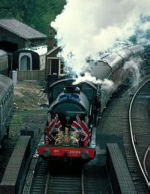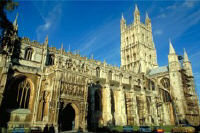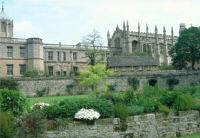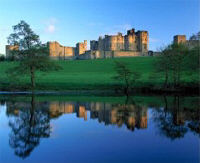The popularity of JK Rowlings’ Harry Potter books makes them the biggest selling series of children’s books in history. The series of books follow the exploits of an 11 year old boy, Harry, who learns that he is the orphaned son of two powerful wizards and possesses magical powers of his own.
He is summoned from his ordinary life with his aunt and uncle to become a student at Hogwart’s, a boarding school for wizards. There he meets others like him and makes new friends who help him conquer the powerful figure responsible for his parent’s deaths.
Turning the pages of Harry Potter and the Sorcerer’s Stone, we’ve all immersed ourselves in the book’s adventures and even imagined ourselves at the Hogwart’s School of Witchcraft and Wizardry. While we may not be able to attend the school we can follow a Harry Potter trail when visiting England.
It starts with the house where Harry lives as he grows up: Number 4, Privet Drive in Little Whinging, Surrey, home of the Dursleys – Harry’s aunt Petunia, uncle Vernon, and cousin Dudley. Number 4 is actually a middle class suburban home in an ordinary neighbourhood, Picket Post Close in Martin’s Heron near Bracknell, Berkshire.
The well known London Underground, a subway system, is where Harry catches the steam train, the Hogwart Express, to the school for wizards. The train leaves from Platform 9¾, and Harry catches it by walking into the barrier that links platforms 9 and 10. This scene was filmed at platform 4 at King’s Cross Station in London, a busy and quite ordinary train station. It was built in 1851 as the London terminus for the Great Northern Railway.

|
|
Severn Valley Railway "Hogsmeade train" |
![]()
Filmgoers may recognize the Hogsmeade train station where Harry arrives to attend the school. It is the station for the village of Goathland in the Yorkshire Moors, already well known from the TV series, Heartbeat that has run on TV for several years. The station, barely changed since 1865, sits at the bottom of a steep hill with a path leading up to the village itself. The steam engine used in the filming is now in service at the Severn Valley Railway in Bridgnorth, Shropshire.
Gringott’s Wizarding Bank, run by goblins, is actually Australia House, a former building of the Australian High Commission, located on the Strand, London, and now a National Trust property. A marble surround, gothic marble columns, and a marble floor are the perfect setting for the below-ground bank vaults that provide a secure place to keep valuables.
Another London location was London Zoo’s Reptile House. Early in the book, Harry goes to the zoo and speaks to a snake that escapes and terrorizes his cousin, Dudley.

|
|
Gloucester Cathedral |
![]()
Located in the city of Gloucester, the stately Gloucester Cathedral choir and its 15th century fan-vaulted cloisters are part and parcel of the film. Edward II was buried here in 1327.
Another cathedral, in the northern city of Durham, was used as a backdrop in the film. Constructed in 995, Durham Cathedral is best known as the resting place for the bones of St Cuthbert. Perched high on a hilltop in a bend of the River Wear, it commands views over the countryside.

|
|
Christ Church |
![]()
The well-known Bodleian Library in Oxford played a key role. Posing as the Hogwart’s Library, it is actually one of a number of library buildings spread throughout the city, but its historic core located at Radcliffe Square was of interest to the filmmakers. One of the city’s oldest buildings, the Christ Church and its Great Hall represented other Hogwart scenes. Its vaulted ceiling is regarded as a masterpiece of English Gothic architecture.
Lacock Abbey, a manor house created from an Augustinian nunnery in 1539 provided interior film locations. Set in Lacock village in Wiltshire, the home’s architecture is a mixture of the nunnery with its cloisters and later Tudor additions. It was the home of William Fox-Talbot, one of the inventors of photography. The entire village is protected by the National Trust, and almost frozen in time.

|
|
Alnwick Castle |
![]()
Alnwick Castle in Northumbria stood in for exterior backgrounds in the Hogwart’s Quidditch match. It’s England’s second largest inhabited castle and has played host to the Percys, Earls and Dukes of Northumberland, since 1309.
Filmed on location in Britain, the settings for the Harry Potter book (Harry Potter and the Philosopher’s StoneTM, in the US: Harry Potter and the Sorcerer’s StoneTM) make for an interesting journey for all Potter fans, young and old.
Travel Information
Oxford
On the A40, Oxfordshire
Divinity School
Open weekdays 9am-5pm, Saturdays 9am-12:30pm
Bodleian Library: not open to the general public but tours are available at the following times: 10:30am, 11:30am, 2pm, 3pm daily; Saturday 10:30, 11:30
Goathland village and train station
Minor road off the A169 from Pickering, North Yorkshire.
Gloucester Cathedral
Gloucester
On the A38/M5, Gloucestershire
Open 10:30-4pm daily except Sun.
Tower tours available
Telephone for more information: from North America (+44) (0) 1452 528095 (weekdays only)
Lacock Abbey
Lacock, Wiltshire
3 miles south of Chippenham, just east of the A350.
Abbey open: end March to beginning Nov., daily 1-5:30pm (closed Tues and Good Friday.
Museum, cloisters & garden: beginning March to beginning Nov., daily 11am-5.30pm (closed Good Fri). Museum also open winter weekends, except Christmas week.
Bracknell
Berkshire
Near London Heathrow airport, on the A322 between the M3 and M4
©2002 by Barbara Ballard. Reproduction of this work in whole or in part, and reproduction in electronic media, without documented permission from the author is prohibited. All photos credit www.britainonview.com (British Tourist Authority website)
Questions?
If you want more information about this area you can email the author or check out our Europe Insiders page.